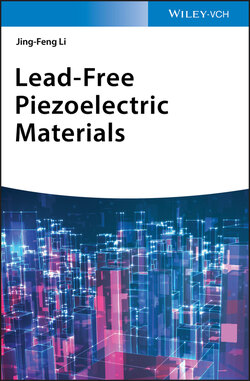Читать книгу Lead-Free Piezoelectric Materials - Jing-Feng Li - Страница 26
2.3 (K,Na)NbO3
Оглавление(K,Na)NbO3 (shortened as KNN) is a solid solution of KNbO3 and NaNbO3. KNbO3 is a ferroelectric material with Tc = 435 °C, while NaNbO3 is expected to an antiferroelectric material with Tc = 640 °C according to the early studies; evidences for the latter's antiferroelectricity are still being investigated. Nevertheless, both compounds can form solid solutions in the full compositional range, analogous to the PZT system that is a solid solution of ferroelectric PbTiO3 and antiferroelectric PbZrO3 [21].
(K,Na)NbO3 ceramics have been investigated quite early, which was found as a piezoelectric material in 1950s. Jaeger and Egerton [22] fabricated highly dense KNN ceramics using hot pressing and reported that the hot‐pressed KNN ceramics possessed high piezoelectric constants and Curie temperature. However, since then there had been only a few reports about piezoelectricity of NaNbO3, KNbO3, or KNN ceramics, probably because of their poor sinterability and high volatility, in addition to their low piezoelectricity compared with the PZT ceramics that have been widely used so far. KNN ceramics have begun to attract special attention again because of a breakthrough made by Saito et al., who obtained high d33 (~416 pC/N) in textured KNN‐based ceramics [10]. Their work not only revealed the potentials of KNN ceramics as a promising candidate for lead‐free piezoelectric ceramics, but also stimulated widespread scientific interest in developing lead‐free piezoceramics.
Figure 2.4 shows the phase diagram of the KNN system [23]. It is quite complicated when compared with the PZT system. Similar to KNbO3, the KNN shows the following polymorphisms within a wide composition range: low temperature (less than −10 °C) rhombohedra (R) phase, room‐temperature orthorhombic (O) phase, high temperature tetragonal (T, 225~435 °C), and cubic (C, >435 °C) phase. However, the phase transitions of NaNbO3 are even more complicated, exhibiting seven polymorphs across the whole temperature range. The temperature‐dependent phase transition of KNN is similar to the case of BaTiO3, but the cubic to non‐cubic phase transition temperature in the former, corresponding to the Curie temperature, is much higher than that of BaTiO3, which is a major advantage of KNN. Therefore, KNN‐based ceramics are considered as the most promising lead‐free piezoceramics with good comprehensive performance (large d33 and high TC).
Figure 2.4 Phase diagram of KNbO3–NaNbO3 system.
Source: Reprinted with permission from Li et al. [23]. Copyright 2013, John Wiley & Sons, Inc.
Significant research progress on KNN‐based ceramics has been achieved in the past years [23–26]. The record d33 of the textured KNN‐based ceramics has been boosted to 704 pC/N in 2018 [27] from the original report of 412 pC/N by Saito et al. in 2004 [10]. Phase boundary engineering is an effective approach to the piezoelectricity enhancement in KNN. Pristine KNN has an orthorhombic phase (O) at room temperature, which transfers to rhombohedral (R) and tetragonal (T) phases at approximately −200 and 200 °C, respectively. Shifting these phase transition temperatures to room temperature by chemical modification has proved to be an effective way to enhance the piezoelectric performance of KNN materials significantly. That is, these two or three phases can be rendered to co‐exist near at room temperature, thereby leading to enhanced piezoelectricity. Such an enhancement is based on the polymorphic phase transition (PPT) effect, which is different from the classic MPB effect. The high piezoelectricity of KNN‐based ceramics deriving from the PPT effect, however, is sensitive to temperature changes [23, 28]; small variations from room temperature can lead to significant drops in the piezoelectricity. Therefore, a simultaneous enhancement of the piezoelectricity and its thermal stability has been one of the focused topics, which is crucial for extending the large‐scale applications of KNN‐based piezoceramics. An effective strategy to this end is making the phase transition boundary diffused [29–31], which will be described later in the corresponding chapter. In addition to the outstanding overall piezoelectric performance, another advantage of the KNN‐based ceramics is their compatibility of co‐firing with Ni electrodes that are much cheaper than Ag/Pd electrodes currently used for PZT multilayer piezoelectric ceramics [32].
